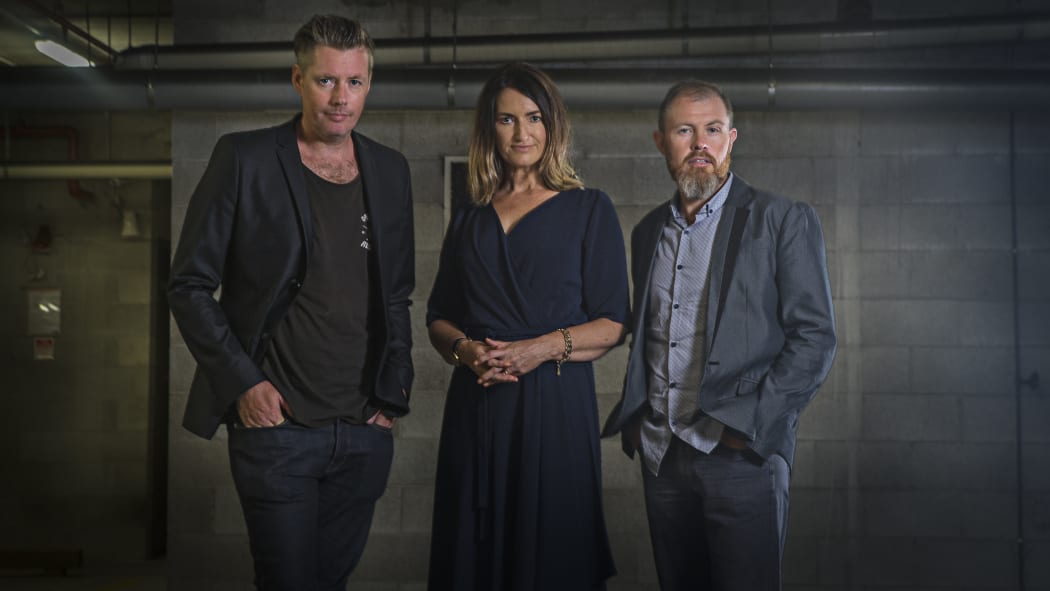NZ On Air is shaking up the way it spends public money on programmes. Mediawatch looks at why the government’s broadcasting funding agency is making the change, and the potential pitfalls in the proposal.

Fairfax Media's moody shot of its investigative video team: Toby Longbottom, Paula Penfold and Eugene Bingham Photo: supplied
Last weekend, Fairfax Media published a major investigation into racism in the justice system. At the heart of it was a 20 minute video for the stuff.co.nz website by journalists Paula Penfold and Eugene Bingham and videographer Toby Longbottom.
Just last year, all three were producing similar work for TV3’s prime time current affairs show 3D. NZ On Air funding supported the show’s journalism, but TV3 canned the programme because it didn’t attract enough viewers and advertising.
Traditional TV fare shifting online like this is one of the reasons NZ On Air is adopting a “platform agnostic” attitude and - as announced today - planning a move to a single public media fund.
Research on viewing habits commissioned by NZ On Air has shown New Zealanders - especially the young – are increasing going online for their screen time, using on-demand services like Netflix, Lightbox, Neon and YouTube.
Big budgets for big broadcasters
In the past, NZ On Air sought to ensure the public got bang for its bucks by ring-fencing most money for programmes screened by mass-audience free-to-air TV broadcasters such as TV3, TVNZ and Prime.
The proposed new NZ Media Fund will instead create four new streams - factual, scripted, music and platforms – which will mean television loses its place as the centre of gravity.
NZ On Air will still send big budgets to free-to-air broadcasters for TV shows, but online and on-demand services will also be able to bid for money to make a wider range of content.
“Cultural or social value, innovation and potential audience size” will be taken into account when considering these applications, the media funding agency says.
Even before the proposed shake-up, this shift was under way.
NZ On Air has funded short series for NZME’s on-demand platform Watch Me. Just this week, the first NZ On Air-funded 'Regional Focus' local news videos appeared on nzherald.co.nz. Neither of these media companies has even been a broadcaster.
The funding moves will alarm the free–to–air TV broadcasters and the local production companies, many of which depend heavily upon public funding for their projects. They also form a powerful lobby within the screen industry.
While the changes will give them avenues to bid for new productions and opportunities to innovate, less of NZ On Air’s capped budget will be available for big-budget domestic productions.
Public broadcasting advocates are also likely to be concerned.
In 1990, NZ On Air effectively replaced the broadcasting fee that people used to pay to receive public broadcasting services. While a wider range of local content on TV and online could come from the new proposed funding system, much of it could be niche content with narrow appeal.
Slicing the pie
Non-broadcast platforms offer choice, but do they cater to the right audience? The ‘Regional Focus’ videos, for example, are certainly freely-available on nzherald.co.nz, but will intended local audiences actually see them there?
There could also be squabbles over how the funding is carved up between genres.
NZ On Air suggests around $42 million a year for “scripted content” encompassing fictional stories, docudrama, telefeatures and comedy series, which could end up on the web, as podcasts or on radio.

Online comedy Flat3 received $100,000 in funding from NZ On Air (and is distributed in partnership with RNZ website The Wireless). Photo: NZ On Air
The “factual” stream has a lower proposed budget of $38m for “audio/visual documentary, specialist journalism and informational content” which is “historical, contemporary, or considering the future”.
Again, the format might be for TV, the web, podcast, interactive or a radio programme. NZ On Air says 70 percent will support "mainstream projects" and 30 percent will fund "special interest and innovation-led content”.
In recent years, NZ On Air has funded TV programmes that would not be made or screened in a wholly-commercial environment through the $15m Platinum Fund. This has funded the last remaining programmes dedicated to politics – TVNZ’s Q+A and TV3’s The Nation and one-offs such as Anzac Day broadcasts and single documentaries.
Will such programmes survive in a system that no longer ring-fences funding for subjects that were once standard fare on TV but are now classed as “special interest”?

